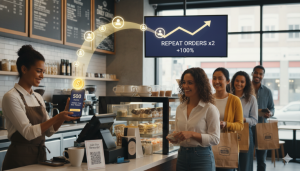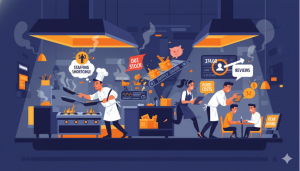Pushing a bunch of tips to start a food business plan for a restaurant is easy when it comes to such write-ups.
We wanted to set things off in a different manner.
To do that, we gathered information from different industry experts because their real-life experiences with the food industry is based on hard facts and age-old experience.
A lot of times, ground realities are different. Therefore, posting articles, loaded with tips, on how to write a fast-food business plan traditionally, doesn’t necessarily cut it. Open your eyes, people. Take a good look around.
At the moment, the food industry is a chaotic mess. Especially, when you consider a post-COVID-19 period, which isn’t exactly labeled: “Post Pandemic” as of yet because we are still dealing with the virus’s severe effects – the playground has changed regardless.
The rules are different; the competition is severe if it wasn’t cutthroat already, and dollars to dimes, your business has as much potential of soaring high as it is doomed to fail within the first few months.
However, we have highlighted not only the most influential tips on how to write a fast-food business plan but also detailed several nitty gritty that are often overlooked by Webmasters in a haphazard effort to gain organic traffic.
Read on…
Starting a Food Business?
If you were to consult with any of the experts at Blink co for business plan ideas, we’d highly recommend considering starting your restaurateur – and that too with a solid high-profile fast-food business plan alongside it.
Would you like to know why?
Food and medicine are two of the main commodities that the human population will continue to consume as long as possible. So, if you thought that just because we were sitting tight in the food business, didn’t make a good connection with the “why” factor of pushing such recommendations.
Whether it’s food or pharmaceuticals, your business will continue to operate with a variance in profit churn. The latter part depends on you – i.e. how you implement your restaurant food business plan for a restaurant, the marketing strategy, overhead expenses, financial resource management, and all the glitz n glam that comes unexpectedly.
Sure, there will be rainy days on a tough streak but the food industry is booming right now. It’s a simple principle: Unlike tech products or any other product for that matter, food is consumable. And don’t we love the fact that people need to “consume” those tidbits of delicacies daily?
If your restaurant’s food menu is capable of eliciting that ‘homely vibe’ where customers are instantly reminded of drooly-worthy goodness that their near relatives used to make, you are going to have a phenomenal breakthrough eventually.
[INSERT_ELEMENTOR id=”1992″]
Writing & Executing a Restaurant Food Business Plan the Smart Way
Food Business Plan Tips for F&B Startups In Post Pandemic Industry
Although many food businesses suffered at the hands of healthcare institute policies after COVID-19 restrictions, it did manage to open a resource pool for potential businesses with a willingness to adapt.
The following food business plan tips are especially for you if you are looking to find out how to write a food business plan right after the pandemic situation. Since a lot of variables have shifted, here’s where you need to shift your focus:
Accelerate off Premises Operations
Ever since COVID happened, many of the restaurants adopted a pro-active approach to off-premise operations.
What does that mean for your brand-new food business?
As part of the revised small food business plan strategy, off-premises operations elicit focus on cashless delivery options, extra emphasis on food cooking safety standards, prevention against takeaways, etc.
Anything that helps to minimize in-person contact with your online food ordering customers is a good strategy. People have become increasingly conscious about social distancing, so, it’s better to practice such protocols through a bunch of revised restaurants’ business plan(s).
Food operators should also know that during COVID, many delivery agents/ companies increased their service charges up to 25%. To reduce this extra cost, you should partner up with an aggregator, such as Blink.
Alternatively, you can also do your own food deliveries to minimize the cost of doing business during a post-pandemic frenzy.
Reclaim Your Brand Voice
The next tip on how to write a food business plan for a post-pandemic industry is to reclaim your brand presence.
Resonate with your customers and healthcare policies by sounding empathic. Those brands and we are not just talking about the food industry operators here, that constantly updated their social media feeds with messages to highlight social distancing, safety healthy practices, and such other slogans, managed to retain and acquire more customers.
An empathic voice tone enables your brand to connect with your customers in a humane way.
Keep Investing in Social Media Marketing Campaigns for Restaurants
COVID’s Delta variant is expected to hit us pretty soon. We do not wish for it to happen, but if it does, you need to be prepared in advance as a smart food business operator.
For a food business plan to work under such circumstances, make sure that you have allocated a portion of your funds to social media restaurant marketing campaigns. It’s nothing new; you have been doing it before. This time, the focus is on reshaping your brand presence by stressing 24/7 online food delivery orders availability, cashless delivery modes, contactless delivery options, and much more.
Literally, anything that puts your customers into a comfort zone is a better idea for your restaurant marketing strategies. Throw in a bunch of limited-time discount deals to maintain food lovers’ interest in the latest menu updates, chef’s specials, and other combo deals that were previously a little pricey on your online food order menu.
We’ll get to the benefits section later. For now, just to be able to get a strong foothold in the food industry, you need a decent chunk of updated information to create a restaurant-food business plan. If ‘Fast Food’ isn’t your thing, you can improvise with the details and tips to see what works in your niche market.
Why should you have a Business Plan for your Restaurant in the first place?
The number one reason why you need a restaurant food business plan is for you to raise funds for your venture.
What do I mean by that? You need to show your plan to banks, governments, and investors this plan so that they know how you plan on succeeding in the short, medium, and long term.
This is why they always need to ask you about a business plan.
The second reason is that in order to raise the right kind of attention for a business partner who you would want to join your venture and hustle as much if not more than you yourself do.
So, you could say they are trying to communicate their own vision to their partners.
But a lot of times it’s difficult to translate what’s in your mind and what’s on the actual business plan itself.
Lastly, it is to have clarity for your business. What does that do? It literally exposes them to challenges which they were not ready for.
It Always Starts with a Problem & a Solution! Here’s why…
For any type of restaurant food business plan, everything falls back to a unique problem statement.
Take a gander around your workplace, street, residential complex, or the nearest local vicinity to see whether they have a fast-food restaurant, or something similar. If there is a brand, or a unit working already, then the next step is to identify their menu.
As an expert, we’d tell you that half of the success and uniqueness rate lies in your food menu. Make it different; let it especially appealing to the audience – but above all, is your food menu solving the problem already?
These problems come in the form of pitiful menu options, poor management, slow servicing, or anything that can cause a churn in customers. Your job is to go out there and see how you can do better.
That’s the bane of any fast-food business plan. A unique identity, with an equally different approach to solving a bunch of customer problems as a smart approach to expanding business.
Why You and No One Else?
Ever thought about why customers should shill over their dollars to you, instead of the other restaurant within an arm’s reach to your location? It’s because of a culmination of strengths that your food business offers.
On a grander scale, if you have a solid food business plan, it has the tenacity to work favorably towards any type of potential business owner.
For instance, some restaurant food corners are very popular as compared to their competitors. Why is that so? These business owners are running a thriving business with minimal overhead expenses (*definitely way too low when compared to a high-profile restaurant), and working to keep customers satisfied.
The answer is simple: offer a different experience to your customers whenever they visit your restaurant.
At Blink Co, we encourage innovation – and for all that we know, it doesn’t matter whether you have raised capital for opening a restaurant, or have enough money to start your food business chain. Just get started, and make sure that your services are fast, efficient, and reliable within at least a 500-meter radius around your brand’s location.
Here’s What your Restaurant Food Business Plan Needs to Cover Beforehand
The aforementioned tips were rather general, as they pinched in the stark realities and challenges associated with the business. The sooner you acknowledge them, and the associated adversity factor, the better it is.
However, what makes you excel in any business, is a bunch of components that make up for an awesome food business plan for restaurants, kiosks, sidewalk eateries – so on and so forth.
-
Branding for your food business:
As we said earlier, the concept behind your food business, restaurant, or any other business for that matter, needs to be different. Based on that, you are looking to create a unique identity with a kickass slogan that is a real head-turner.
By concept, what I’m alluding to is what concept are you going to bring to the world? What concept are you trying to offer your customers?
What problems does it solve?
And why will you and your restaurant be the ones which will solve that problem…
Why you are uniquely capable of solving this problem.
It needs to cut right to the chase – it should at max be of 1 page in length.
You just need to identify the opportunity and how you are going to fulfill this demand.
-
Sample Menu:
Over the last couple of years, restaurant and general order food menus have changed. The dine-in experience is often surpassed by the “takeaway” experience. So, in an ideal scenario, you need to have two kinds of sample menus as part of your food business plan.
-
Things go beyond the visual appeal of a menu. Here’s why:
We believe that incorporating your logo and some mockup templates in a visually intriguing manner don’t cut it. Your food business relies on a menu that includes prices based on a detailed cost analysis.
This cost analysis is further based on whatever your competition is offering within a 100-mile radius. Okay, the distance may be exaggerated, and you can reduce it to 10 miles radius as a new business, but you get the idea, right?
As a sole proprietor, you may not have trouble with your menu and you might not be able to see the lingering issues in it. But, if you are working in partnership, or with potential investors, your sample menu should give a clear idea and understanding of targeted price points, financial projections, and USPs in terms of cost-benefit to customers.
And only then, should you work extra hard to make the menu visually appealing. This step is always second, but many new food business plan owners give it a top priority over other important ideas associated with sample menus.
-
Servicing:
We could write a thesis-sized document on the level of different services that go on in the food industry.
According to the experts, the benchmark standards of the servicing section, alone, break down into different aspects. Take a look at any Michelin Star restaurant, its services cover the following aspects from a general point of view:
- Visuals-oriented services are associated with the actual food layout; the way it’s cut and presented on a shiny platter and everything else. This is a huge responsibility for the chef working behind closed quarters.
- The code and conduct of restaurant staff
- How soon can people get reservations
- How about vacating reservations for people on the waiting list?
- Customer support through active phone calls
Most importantly, if it’s a Michelin Man coming in for a review of the restaurant’s services, within 20 minutes he or she will drop a spoon on the floor. This discreet gesture is part of their service testing rituals to notice if any of the staff observes the accident and picks it up to offer a clean spoon.
Case in point, if you are aiming to match a high-end restaurant’s servicing standards, your plan needs to focus on it from the get-go. Such restaurants’ food business plan is slightly different – as in, it focuses on premium level services through an expensive approach that is often not suitable for startup level business owners.
On a separate note, Michelin restaurants do not deliver food through food ordering apps. Their focus is on the dine-in experience. However, the shift in the industry due to COVID-19 has called for a slightly different outreach strategy where some of the high-profile restaurants are delivering their exquisite delicacies through food ordering apps.
Read more: The 24 Fine Dining Michelin Restaurants are Delivering Food in London
-
Management Team & Their Goals:
As part of the fast-food business plan core components, management fills in the cracks as a way forward for business to move.
Define a set of overview guidelines on a bi-annual basis. From a retrospective perspective, this overview should reflect what management has been able to achieve in the past; your accolades and failures too, and the future plan for the upcoming fiscal year.
Ideally, you should be looking to demonstrate every person’s work experience in the form of their respective strengths and weaknesses. Doing so is important because management is all about changing for the better.
Oftentimes, this “change” comes as a heavy sacrifice. But if an important member of the managerial team isn’t able to perform optimally, you need to have a strong suit to call for a replacement or a role reassignment.
-
Design Schematics:
Design schematics are part of the fast-food business plan. Since design and architecture are an expense – and that too on the high side, the startup food business plan should focus on doing just enough to introduce a visually unique on-site restaurant design.
For instance, if you are planning on doing some baking in a traditional kiln, why don’t you add a fancy illustration about it somewhere on your restaurant wall? To that effect, murals also work well.
-
Location:
Ever heard of the ‘Location, Location and Location’ expression?
We think you have. Even if you haven’t heard about it, at least you get the reference. The real-life location of any business is like a direct portal between the target market, customers, and steady profits.
At the earliest stages of your food business plan, you may not have highlighted the exact location of the soon-to-be-inaugurated business. Therefore, you can count on finalizing the location later. Whatever you decide to do, you need to move to an easily accessible area with direct exposure to as many target audiences as possible.
This isn’t easy because prime locations come at a huge cost. For example, corner-side restaurant locations are expensive because they overlook at least two sides of the street. However, the cost factor is mitigated by a healthy client percentage.
As of now, if you don’t have a site mentioned in your restaurant food business plan, then you have the opportunity of scavenging for one. Take your time and see what you can come up with.
-
Surveying and Doing your homework
Go to your neighbor’s restaurant and record how many visitors and footfalls that they have and what kind of orders they are getting. You can articulate how much money they are making every hour.
You can now have a very clear idea of how well this restaurant is functioning.
Once again, these are all projections. It is just important because this way you can tell your bankers and investors how you came up with these numbers based on evidence.
Just showcases your initiative-taking capability.
Market Landscape for Fast Food & Restaurant Food Businesses after COVID
As far as the market overview goes, there are two constants in the micro and macro niche.
Top it off with a severe impact that COVID has made on all types of businesses in the form of heavily imposed restrictions.
If we were to talk about the pandemic from a restaurant’s point of view, there are two main scenarios. The first one is the fact that not as many people are visiting their favorite go-to locations due to health concerns. Even if restaurant owners and customers are willing to continue doing business, the health department restrictions work against the tide.
If you are looking to create a food business plan, make sure it has something to the effect of ‘What to do during and after COVID-19 era as a restaurant owner?’
The good news is that COVID isn’t permanent. It might be long-lasting, but sooner or later, the world will get rid of it. However, by that time, things would have changed already.
At a micro level, your potential competitors are already working on mitigating profit loss through scarce walk-in customers by transitioning to food ordering apps.

Before COVID’s breakthrough, demographics show that millennials, GenZ, and baby boomers were more likely to swipe through any food ordering application because a dine-in experience was deemed preferable. The arrival of the COVID-19 pandemic worked as an off-premise equalizer where the same customer scrambled to get the same type of food through remote access.
As of now, 53% of adults are purchasing takeout or delivery through food ordering applications. Meanwhile, 68% of customers are willing to purchase takeout delivery because they are not only concerned about personal wellbeing, but the overall takeout experience is reportedly much better than driving to the nearest restaurant.
According to January Statistics, shared by the National Restaurant Association’s State of Industry report, food ordering portals have become increasingly popular due to ongoing consumer-side demand. 46% of family restaurants indicate that they introduced a special takeout menu after carefully reevaluating the food business plan.

Between March and December 2020, 44% of the restaurants have already made the transition to the food ordering application experience. This was done by either signing up with reliable companies, such as Blink Co, for a safe and guaranteed food ordering system that works to service customers and maximizes restaurant profits altogether.
Speaking of increased profits, Blink Co. is a subscription-based service where restaurants don’t have to pay a flat commission percentage for every customer order. Blink Co simply charges a nominal monthly fee to enable the restaurants to work at their optimal levels.
Fortunately, the resilience and apt of seasoned restaurant food businesses and restaurant owners have been nothing short of amazing. Although physical contact is limited due to healthcare concerns, if your food business plan has worked to establish a strong foothold, already, then your customers will support you.
People in the Mr. Espresso orbit like to think so. According to the business’s owner, the pandemic hasn’t stopped customers from placing their orders repeatedly. But then again, the restaurant did acknowledge that they included a robust social media and online marketing campaign to spread the word about the services available through online food ordering apps.
The Meet You Out Front Dilemma
The sooner you realize that building a business these days, especially during an ongoing global pandemic, it’s all about building a community instead. Do that in unexpected ways, by creating viral social media campaigns; connect with people without ever meeting them through online stories, and genuinely show that you care about your customers.
Take a look at the following graph to see the percentage of restaurant owners who switched to other modes of offering their services.

Normalcy will soon be making a comeback in the market. But, by that time, your average customer will not completely shift back to the in-house dining experience as an essential growth driver.
Food ordering through remote channels has become a fad now. Include a divisive plan to cater to your distant target market’s needs so that your business remains unaffected in the long run.
Putting It All Together:
Today’s food business plan defies the traditional boundaries of typical business outlines that were set out in black in white several years ago.
We just wanted to fill you in on a very different intake on starting a food business nowadays. To that end, the aforementioned tips and tricks are just enough to nudge you in the right direction. If you need a perfect food business plan with carefully forecasted numbers, projections, and vice versa, go ahead and seek professional services.
If you have dabbled already in the food business industry, we would love to hear your thoughts on this. How is your business doing now? Have you tried a remote food ordering application for restaurants? If you haven’t, why not?
FAQs about Restaurant Food Business Plan:
1. Why Do you Need to Have a Restaurant Business Plan in the first place?
The reason for having a food business plan for any niche market comes down to a few factors. Sense of direction is the most important point, illustrating your roadmap that further branches into where you need to focus the most.
Other than that, a solid business plan always sheds insight on expense management, an often-overlooked factor at times. The old school of management believes in the ‘J.I.T’ (Just in Time) approach to get business plans up and running in “no time.”
Unfortunately, the current industry and post-pandemic era have their own pressing matters where you are not able to ‘deal with food business plan’ constraints as they come up. There has to be a pre-planned set of policies, rules, and agreements to highlight budgeting forecasts, expense monitoring, infrastructure management, and other variants of a fully thriving restaurant in near future.
2. Foundations of a solid restaurant business plan: defining your target market, USP, restaurant-style, select your food type/menu offering, define your brand.
Although it is possible for a restaurant to focus on multiple food styles, cultural delicacies, and other unique selling points to alleviate sales and marketing experience, it is an ill-advised approach.
If you are planning to hit the big leagues in the food industry, start small and scale as you go up. For starters, your food menu should be simple so that chefs can prepare the food in no time, while the front end works to cater to customer requirements and remote food orders through apps.
Price-wise, your edge lies in affordability. Keep the food simple and tasty enough, while your customers are able to easily buy it on a whim. That being said, yes, it is true that there are high-profile restaurants that are often jam-packed, but their marketing and business plan strategy had always been focused on a specific target market.
For new business owners, it is strongly recommended to have a basic set-up available where food can be prepared on time, expenses are at the minimum and affordability scales up according to your audience. That’s one element of your USP.
Other plus points to a phenomenal USP profile are setting up a restaurant in an easily accessible place, excellent customer support, no waiting time for walk-in customers, a fast ordering system through food aggregator apps, and vice versa.
3. How much money to start a food truck business in UAE?
The cost of setting up a food truck business in the UAE ranges in the $35K (AED 135,000) region on average, according to the co-founder of Bespoke Trailers, a UAE business that is functional and profitable.
4. How does promotion help a food and beverage business?
By using promotional and marketing strategies that highlight the taste, presentation, and perhaps price point of your restaurant items, you can capture a segment of your target market interested in your restaurant. Effective marketing strategies can also help transform new customers into regular customers.
Good luck and have fun with your very first food business plan.









